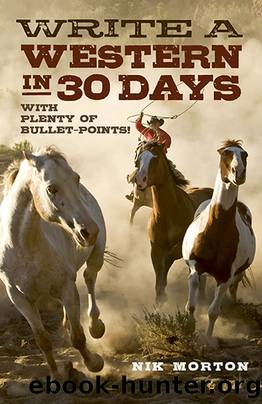Write a Western in 30 Days by Morton Nik;

Author:Morton, Nik; [Morton, Nik]
Language: eng
Format: epub
ISBN: 1210661
Publisher: John Hunt Publishing Limited
Published: 2013-06-28T00:00:00+00:00
Motivation
As can be seen in the samples of backstory, there are several instances where character motivation has been embedded. People generally donât do something without a reason. Theyâre motivated by pride, greed, altruism, love, anger, jealousy, hate and a lot more besides.
Lydia hates Mexicans, because her husband found love and solace in a Mexican womanâs arms. The child of that union was Corbin, of course â so she doesnât like him, either â his mixed race is a constant affront to her. So her past shapes how she feels towards the Mexican workers at the silver mine. Her past provides her with powerful motivation for her current actions and intent.
Certainly, incidents or people in their past might return to haunt them. By building a past for your characters, they cease to be made of cardboard. Within a short while, theyâll seem alive.
Somerset Maugham has said that every action of a character must be the result of a definite cause â significantly related to the entire fiction, of course.
Each motive must be in keeping with the characterâs behaviour pattern that youâve established. Otherwise, you lose credibility.
Conflict
Without conflict of some kind, there is no story. The conflict doesnât have to be life or death â but it must test your hero or heroine to the utmost. How the protagonist rises above the conflict emphasises that characterâs major emotional trait.
Each test must be a crisis â a critical time in the protagonistâs life.
There have to be obstacles in the characterâs way, making the test difficult.
Your characters must be in conflict â whether with their consciences, their families or neighbours or the antagonist.
Conflict types:
Supernatural
Human
Other entities â animals, wildlife etc.
Non-living entities â things and objects of every kind
Natural forces â time, the elements, disease
Social forces â economic conditions, politics, morality, religion etc.
Inner self â conscience, belief system, loyalties and repressed self
All of the above conflict types can be used in a western â yes, even the supernatural!
That conflict keeps the pages turning. Introduce conflict of some kind early and pile it on throughout the book, saving the greatest obstacle for the end.
In the first paragraph of the Prologue in The $300 Man, the protagonist Corbin Molina is faced with serious conflict. Heâs being robbed at gunpoint on a train.
Naturally, I wanted Corbinâs hook to be seen by the reader as soon as possible, so I managed that in the second slightly long paragraph.
Perched on the edge of his aisle seat on the right-hand side of the swaying railway carriage, Corbin was coiled like a spring, biding his time, ready to jump the robbers. The money didnât concern him too much; it was the opened envelope Granger had taken with the cash: if the train-robber read the letter inside, heâd more than likely shoot Corbin where he sat. A thin-lipped smile was the only expression on his reddish-brown features as he held his arms aloft, the left terminating in a stump encased by a metal band and brandishing a hook. Further up the carriage was a forest of upheld arms.
Download
This site does not store any files on its server. We only index and link to content provided by other sites. Please contact the content providers to delete copyright contents if any and email us, we'll remove relevant links or contents immediately.
| Authorship | Bibliographies & Indexes |
| Book Industry |
Asking the Right Questions: A Guide to Critical Thinking by M. Neil Browne & Stuart M. Keeley(5356)
Autoboyography by Christina Lauren(5086)
Dialogue by Robert McKee(4160)
Eat That Frog! by Brian Tracy(4149)
Sticky Fingers by Joe Hagan(3912)
Journeys Out of the Body by Robert Monroe(3460)
Annapurna by Maurice Herzog(3298)
Full Circle by Michael Palin(3268)
Elements of Style 2017 by Richard De A'Morelli(3235)
Schaum's Quick Guide to Writing Great Short Stories by Margaret Lucke(3187)
The Art of Dramatic Writing: Its Basis in the Creative Interpretation of Human Motives by Egri Lajos(2857)
The Diviners by Libba Bray(2800)
Why I Write by George Orwell(2774)
The Mental Game of Writing: How to Overcome Obstacles, Stay Creative and Productive, and Free Your Mind for Success by James Scott Bell(2766)
In Patagonia by Bruce Chatwin(2755)
Atlas Obscura by Joshua Foer(2705)
The Fight by Norman Mailer(2700)
Venice by Jan Morris(2430)
The Elements of Style by William Strunk and E. B. White(2377)
